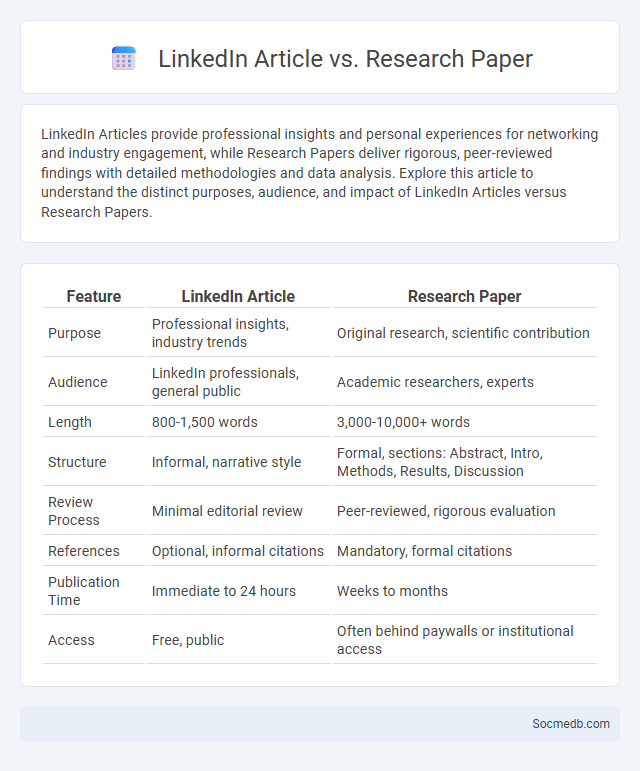
Photo illustration: LinkedIn Article vs Research Paper
LinkedIn Articles provide professional insights and personal experiences for networking and industry engagement, while Research Papers deliver rigorous, peer-reviewed findings with detailed methodologies and data analysis. Explore this article to understand the distinct purposes, audience, and impact of LinkedIn Articles versus Research Papers.
Table of Comparison
| Feature | LinkedIn Article | Research Paper |
|---|---|---|
| Purpose | Professional insights, industry trends | Original research, scientific contribution |
| Audience | LinkedIn professionals, general public | Academic researchers, experts |
| Length | 800-1,500 words | 3,000-10,000+ words |
| Structure | Informal, narrative style | Formal, sections: Abstract, Intro, Methods, Results, Discussion |
| Review Process | Minimal editorial review | Peer-reviewed, rigorous evaluation |
| References | Optional, informal citations | Mandatory, formal citations |
| Publication Time | Immediate to 24 hours | Weeks to months |
| Access | Free, public | Often behind paywalls or institutional access |
Introduction to Content Types
Content types on social media encompass diverse formats such as images, videos, stories, reels, and live streams, each designed to engage audiences in unique ways. Visual content, including infographics and branded graphics, significantly boosts user interaction and shareability across platforms like Instagram, Facebook, and LinkedIn. Understanding the strengths and algorithms of each content type enables marketers to tailor strategies for maximum reach and engagement.
Defining LinkedIn Articles
LinkedIn Articles are long-form content pieces published directly on the LinkedIn platform, designed to showcase expertise and thought leadership within your industry. These articles allow you to provide in-depth insights, share professional experiences, and engage your network beyond standard posts. Leveraging LinkedIn Articles can enhance your personal brand and increase visibility among your professional audience.
What Is a Research Paper?
A research paper is a detailed, structured document presenting original findings or in-depth analysis on a specific topic, often supported by evidence and scholarly sources. In social media, research papers explore trends, user behavior, and platform impact, providing valuable insights for marketers, developers, and users like you. Crafting a research paper involves critical thinking, systematic investigation, and clear communication to contribute knowledge to the field.
Understanding General Articles
Understanding general articles on social media involves analyzing content structure, key themes, and target audience engagement. Effective interpretation requires recognizing common writing styles, identifying credible sources, and discerning underlying messages within posts and comments. Mastery of these skills enhances critical thinking and enables users to navigate information biases and misinformation on platforms such as Facebook, Twitter, and Instagram.
Purpose and Audience Comparison
Social media platforms serve diverse purposes, from professional networking on LinkedIn to visual storytelling on Instagram, each tailored to specific audience needs and behaviors. Understanding the demographic and psychographic profiles of users helps brands customize content for engagement, such as targeting millennials with interactive Instagram campaigns or professionals with informative LinkedIn posts. Analyzing audience interaction metrics provides insights into platform effectiveness and content relevance for optimizing marketing strategies.
Structure and Format Differences
Social media platforms vary significantly in structure and format, affecting how content is created and consumed. Twitter emphasizes concise text-based posts with character limits, while Instagram prioritizes visual content like photos and short videos, often enhanced by hashtags and stories. Understanding these format distinctions helps you tailor your content strategy to maximize engagement and reach on each platform.
Depth of Research and Evidence
Comprehensive analysis of social media impact draws from extensive studies involving behavioral psychology, communication theory, and data analytics, providing robust empirical support for its effects on mental health and social dynamics. Quantitative evidence from large-scale surveys and algorithmic behavior tracking highlights correlations between platform usage patterns and cognitive outcomes. Peer-reviewed research consistently underscores the nuanced influence of social networks on information dissemination, user engagement, and societal polarization.
Writing Style and Tone
Crafting content with a consistent writing style and tone enhances your social media presence by resonating deeply with your target audience. Employing a conversational, authentic, and engaging voice helps build trust and encourages interaction across platforms. Your tone should reflect your brand's personality while adapting to the preferences and expectations of each social media channel.
Publication and Review Process
Your social media publication and review process ensures content quality and aligns with brand guidelines by incorporating scheduled drafts, editorial approvals, and compliance checks. Automated tools and analytics platforms facilitate monitoring engagement metrics and flagging potential issues before posts go live. Streamlined workflows help maintain consistency, improve audience trust, and boost overall online presence.
Choosing the Right Format for Your Content
Selecting the optimal format for your social media content hinges on understanding your target audience's preferences and platform-specific trends. Visual formats like videos and infographics often drive higher engagement rates, while concise text posts can effectively convey information quickly. Tailoring your content format maximizes reach and interaction, enhancing Your brand's online presence.
 socmedb.com
socmedb.com